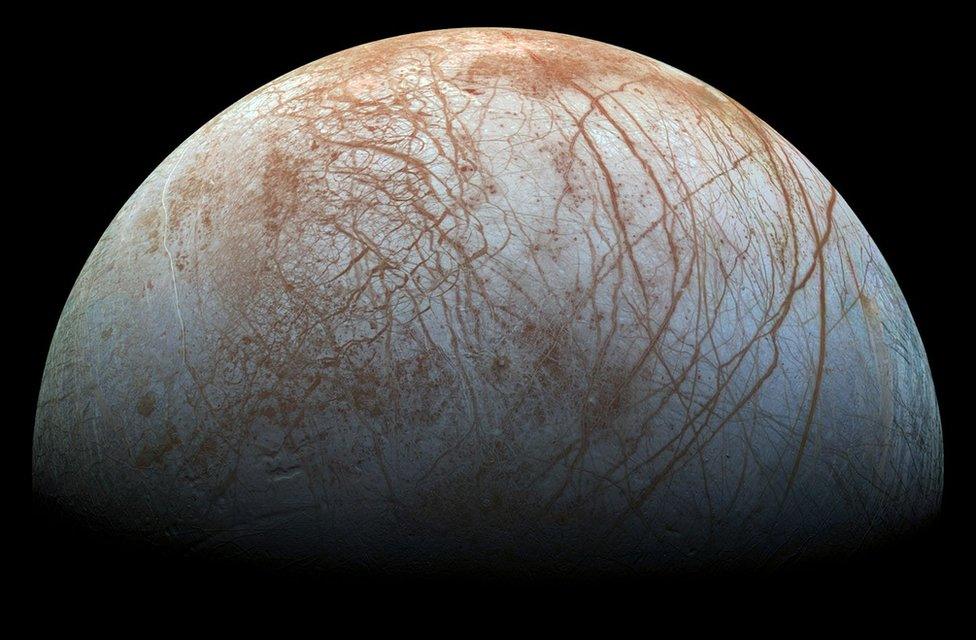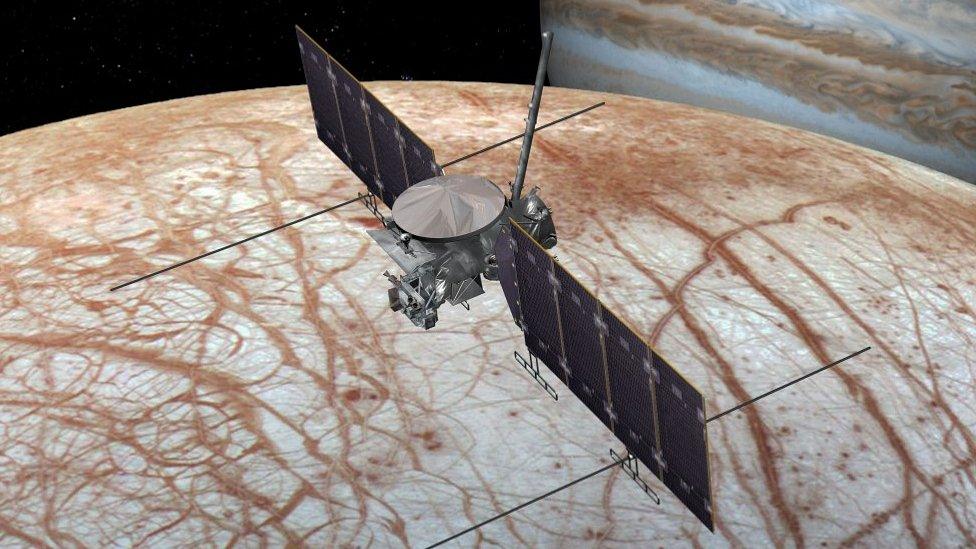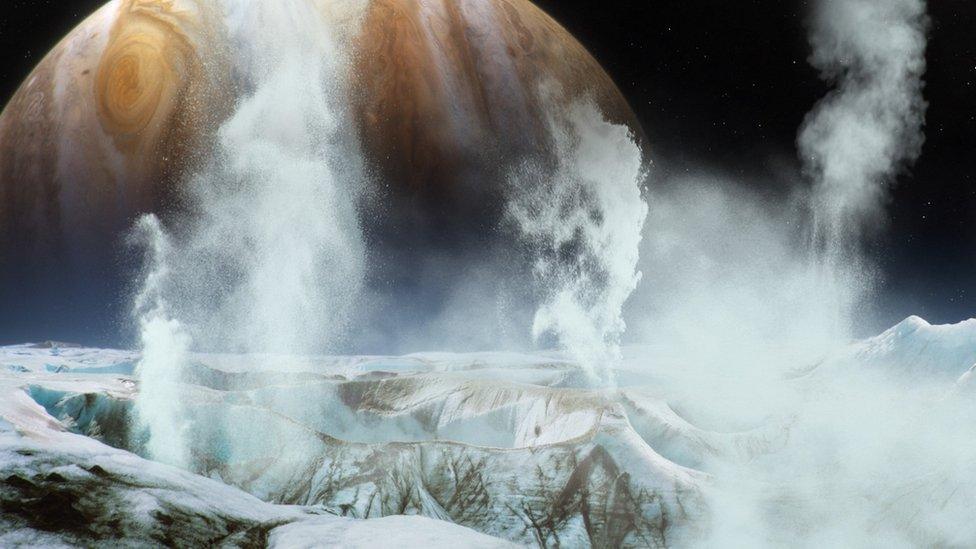Europa: Our best shot at finding alien life?
- Published
- comments

Europa holds a vast, salty ocean beneath its fractured ice shell
After two decades of development and "heartbreak", scientists are on the verge of sending missions to explore the ocean world of Europa. Could this be our best shot at finding life elsewhere in the Solar System?
Orbiting the giant planet Jupiter is an icy world, just a little smaller than Earth's moon.
From a distance, Europa appears to be etched with a nexus of dark streaks, like the product of a toddler's chaotic scribbling.
Close up, these are revealed to be long linear cracks in the ice, many of which are filled with an unknown contaminant that scientists have dubbed the "brown gunk". Elsewhere, the surface is tortured and irregular, as if massive slabs of ice have drifted, spun and flipped over in slush.
Jupiter's immense gravity helps generate tidal forces that repeatedly stretch and relax the moon. But the stresses that created Europa's smashed up terrain are best explained by the ice shell floating on an ocean of liquid water.
"The fact that there's liquid water underneath the surface which we know from previous missions, in particular from the magnetometer observations made by the Galileo spacecraft as it flew past [in the 1990s], makes it one of the most exciting potential targets to look for life," says Prof Andrew Coates of UCL's Mullard Space Science Laboratory, external in Surrey, UK.
Europa's dark, briny deep might extend 80-170km into the moon's interior, meaning it could be holding twice as much liquid water as there is in all of Earth's oceans. And while water is one vital prerequisite for life, Europa's ocean might have others - such as a source of chemical energy for microbes.

Artwork: Europa Clipper will make at least 45 flybys of the jovian moon during its primary mission
However, the ice shell that surrounds the ocean is thought to be tens of kilometres thick. On the face of it, this might make any notions of exploring Europa's watery depths seem like a far-off fantasy.
Luckily, scientists think there are a number of ways for the ocean to communicate with the surface. For example, the physical process of heat transfer known as convection may cause warm blobs of ice located deep within the shell to travel upwards to the surface. So studying the moon's outer face could provide clues to what's going on far beneath it.
Now, Nasa is priming two missions to explore this intriguing world. Both have been discussed here at the 48th Lunar and Planetary Science Conference (LPSC) in Houston, external. The first is a flyby mission called Europa Clipper, external that would likely launch in 2022. The second is a lander mission that would follow a few years later.
Dr Robert Pappalardo, from Nasa's Jet Propulsion Laboratory (JPL), external, is Clipper's project scientist.
"We're really trying to get at Europa's potential habitability, the ingredients for life: water, and whether there's chemical energy for life," he tells me. "We do that by trying to understand the ocean and the ice shell, the composition and the geology. And mixed into those is the level of current activity at Europa."
Clipper carries a payload of nine instruments, including a camera that will image most of the surface; spectrometers to understand its composition; ice-penetrating radar to map the ice shell in three dimensions and find water beneath the ice shell; and a magnetometer to characterise the ocean.
Prof Andrew Coates explains why Europa is a good place to look for life beyond Earth
However, since the Galileo spacecraft provided evidence for an ocean in the 1990s, we've learned that Europa isn't one of a kind.
"One of the most amazing and significant discoveries of the past decade or so in planetary exploration is that you can't swing a dead cat in the outer Solar System without hitting an ocean world," says Clipper's programme scientist Curt Niebur, from Nasa headquarters, external in Washington DC.
At Saturn's moon Enceladus, for example, ice from a subsurface ocean gushes into space through fissures at the south pole.
The saturnian satellite could also get a dedicated mission in the 2020s, but Dr Niebur believes Europa stands out: "Europa is much larger than Enceladus and has more of everything: more geological activity, more water, more space for that water, more heat, more raw ingredients and more stability in its environment."
In Europa's rocky interior, heat is probably generated by tidal forces and by the decay of radioactive isotopes. Scientists think the heating may drive volcanic vents on the seafloor - an important point in favour of the moon's habitability, since terrestrial vent systems support a wide array of life forms.
But there's something else that marks the moon out: its neighbourhood. Europa's orbital path takes it deep into Jupiter's powerful magnetic field, which traps and speeds up particles.
The resulting belts of intense radiation fry spacecraft electronics, limiting the durations of missions to months or even weeks. That said, this radiation also drives reactions on Europa's surface, yielding chemicals called oxidants. On Earth, biology exploits the chemical reactions between oxidants and compounds known as reductants to supply the energy needed for life.

Artwork (not to scale): Europa in cross-section, showing processes from the seafloor to the surface (Europa Lander Study 2016 Report)
However, the oxidants made on the surface are only useful to Europan microbes if they can get down into the ocean. Fortunately, the process of convection that pushes warm blobs of ice upwards might also drive surface material down. Once in the ocean, oxidants could react with reductants made by seawater interacting with the rocky ocean floor.
"You need both poles of the battery," explains Robert Pappalardo.
For scientists like Bob Pappalardo and Curt Niebur, the impending missions are the realisation of a two-decades-long dream. Since the first Europa mission concepts were drawn up in the late 1990s, one , externalpromising , externalproposal, external after another has been thwarted.
During the noughties, the US and Europe even pooled resources on a mission that would have sent separate spacecraft to Europa and Jupiter's larger ice moon Ganymede. But the plan was cancelled amid budget cuts, with the European part evolving into the Juice mission., external
"I don't think there's been a Europa mission over the past 18 years that I have not either had my fingers in or has not passed under my eye," says Curt Niebur.
"It's been a long road. The road to launch is always a rocky one, and it's always full of heartbreak. We've experienced that more than most on Europa."
Exploring Europa is costly - though no more so than other Nasa "flagship" missions such as Cassini or the Curiosity rover.

Four views of Europa's surface from the Galileo mission, clockwise from top left: (1) disrupted ice crust in the Conamara region; (2) crustal plates, which are thought to have broken apart and "rafted" into new positions; (3) reddish bands; (4) an impact structure about the size of Hawaii
There are inherent engineering challenges, such as operating within Jupiter's radiation belts. Spacecraft instruments need to be shielded with materials such as titanium metal but, says Dr Pappalardo, "you can only shield them so much because they have to be able to see Europa".
So to keep Clipper safe, Nasa is going to stray from the rulebook somewhat. "The assumption always was: Galileo flew past Europa, so the next mission has to be an orbiter. That's just how we do business," says Dr Niebur. But rather than orbit Europa, Clipper will instead reduce its exposure to mission-shortening radiation by orbiting Jupiter, and make at least 45 close flybys of the icy moon over three-and-a-half years.
"We realised we could avoid those technical challenges of orbiting Europa, make the mission much more achievable and still get the science we want if we fly past it a lot," says Clipper's programme scientist.
The strength of sunlight near Europa is about a 30th of what it is at Earth. But Nasa decided it could power Clipper with solar panels rather than the radioactive generators some other outer planet missions have used. "All those years of study forced us to burn away our pre-conceptions and get us to really focus on reality, not on our wish-list... to focus on the best science," says Curt Niebur.
In 2011, a National Research Council report, external re-stated the importance of exploring the icy moon. Even so, Nasa remained wary because of the cost.

Artwork: Nasa's Europa lander could determine whether there was or is life on the jovian moon
But the support on Capitol Hill has been pivotal. A Europa venture has bipartisan backing, and in Republican Congressman John Culberson, external - the chair of the particular House Appropriations Subcommittee with jurisdiction over Nasa's budget - the mission has had a unique champion.
The 60-year-old Texan lawmaker has been entranced by Europa ever since observing it through the Celestron 8 telescope he bought himself as a high school graduation present. Over the last four years, the subcommittee he chairs has channelled money to scientists working on Europa, external, even when the space agency's chief wasn't asking for it.
Generous investment means that much more of the technical work has been completed on Clipper than is normal for a mission at its stage (phase B) in the Nasa project cycle. The lander is at an earlier stage of development, called pre-phase A, but a report on the mission's science value, external was discussed at a workshop, external here at the LPSC.
The lander has received no funding in the President's 2018 budget request for Nasa. But Dr Jim Green, external, director of planetary science at the agency, tells me: "That mission in particular is tremendously exciting, because it tells us the science we have to do from the surface of a moon that's really hard to get to.
"We still have quite the process to go through, do the due diligence, understanding the kind of measurements we need to make. Then we'll work with the administration in the future at the right time to see if, budgetarily, we can move forward with it."
Dr Geraint Jones explains how to punch through the hard icy surface of Europa
Some innovative Europa lander concepts have been proposed over the last two decades, reflecting the scientific bounty to be had by touching down. Dr Geraint Jones of the Mullard Space Science Laboratory has worked on one concept called a penetrator.
"They haven't been flown in space before, but it's a really promising technology," he explains. A projectile deployed from a satellite hits the surface "really hard, at about 300m/second, about 700 miles an hour", exposing pristine ice for analysis by onboard instruments, which could be designed to withstand the impact.
By contrast, Nasa's forthcoming lander would put down softly with the help of the Sky Crane technology used to drop the Curiosity rover safely on Mars in 2012. During the touchdown, it will use an autonomous landing system to detect and avoid surface hazards in real time.
Clipper will provide the reconnaissance for a landing site. "I like to think of it as finding that right oasis, where there might be water close to the surface. Maybe it's warm and maybe it has organic materials," says Bob Pappalardo.
The landing craft would be equipped with a sensitive instrument payload and a counter-rotating saw to help get at fresher samples below the radiation-processed surface ice.
"The lander is all about hitting the freshest, most pristine sample possible. One way to do that is to dig deep, another way is going to where there is some kind of eruption on the surface - like a plume - that's dropping very fresh material onto the surface," says Curt Niebur.

Artwork: The Hubble telescope has seen possible evidence of geysers on Europa

Life teems around hydrothermal vents on Earth; but what's going on in the depths of Europa's ocean?
In recent years, the Hubble telescope has made tentative observations of plumes of water-ice erupting from beneath Europa, much as they do on Enceladus. But there's no point in the lander going to the site of a decades-old eruption; it would need to visit the location of a much more recent plume.
So scientists need to understand what's controlling these geysers: for example, Clipper will determine whether the plumes are correlated with any hot spots on the surface. The lander's arm could even reach out to sample the mysterious "brown gunk" which might, according to one idea, represent radiation-baked sea salt.
Earth's seas are teeming with life, so it can be hard for us to contemplate the prospect of a sterile, 100km-plus deep ocean on Europa. But the scientific threshold for detecting life is set very high. So will we be able to recognise alien life if it's there?
"The goal of the lander mission is not simply to detect life [to our satisfaction], but to convince everyone else that we have done so," Dr Niebur explains. "It does no good for us to invest in this mission if all we create is scientific controversy."
Thus, the lander's science definition team came up with two ways to address this. First, any detection of life has to be based on multiple, independent lines of evidence from direct measurements.
"There's no silver bullet; you don't do one measurement and say: 'aha, eureka we've found it'. You look at the sum total," says Dr Niebur. Second, the scientists have come up with a framework to interpret those results, some of which might be positive, while others negative: "It creates a decision tree that marches through all the different variables. Following all these different paths, the end result is: yes, we've found life, or no we haven't," he says.
At the lander workshop here at the LPSC, Nasa's Kevin Hand described the process as "biosignature bingo". Now, the team will have to see if the scientific community is persuaded.
Curt Niebur explains: "I want to have that discussion now, today, years before we launch so that we can all be focused on analysing the data once we land."
Follow Paul on Twitter., external
.